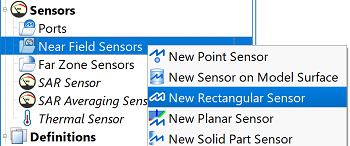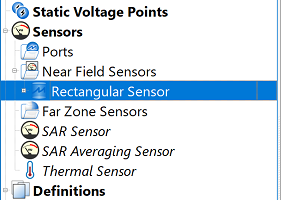
The ![]() Rectangular Sensor uses two points in a local coordinate system to define a rectangle in the simulation space on which to collect data. The associated surface sensor definition specifies which data to collect on the rectangle.
Rectangular Sensor uses two points in a local coordinate system to define a rectangle in the simulation space on which to collect data. The associated surface sensor definition specifies which data to collect on the rectangle.
Users can create a rectangular sensor by right-clicking on Near Field Sensors in the Project Tree, then selecting New Rectangular Sensor. The editor across the top of the Geometry window consists of three tabs: Specify Orientation, Rectangle, and Properties.

Under the Specify Orientation tab, users can define the U', V', W' local coordinate system of the sensor. The editor provides multiple options for defining both the origin and orientation of the U', V', W' vectors, and the advanced settings, direction picking tools, and alignment tools provide additional methods for making adjustments. The two points defining the rectangular sensor are specified in the U', V' plane.

Under the Rectangle tab, users can define the rectangle's two opposite corners by entering a U' and V' value for each set of coordinates.

Under the Properties tab, users can enter a sensor identifier into the Name field, and specify the associated Sensor Definition by choosing from the current project's existing sensor definitions listed in the drop-down menu. A definition must accompany each rectangular sensor in order to determine which time- and frequency-domain data to collect across each surface.
Users can also specify the Sampling Method by choosing from the drop-down menu. Selecting Snapped to E-Grid sets the location of the rectangular sensor to the nearest E-grid cell vertex. A snapped surface sensor's field components come from the cell whose lowest-index corner is defined by the snapped location of the sensor. Users should note that sensor location is therefore dependent on the grid definition.
Selecting Field Interpolation performs linear interpolation among the surrounding eight appropriate field value sample points in order to place the field components at the exact location of the surface sensor.
Users can either enable or disable each surface sensor by selecting or deselecting the Enable Surface Sensor option, respectively.
Four buttons provide options for completing changes to the editor:
- Revert: discards changes and restores the previously saved settings.
- Done: closes the window and saves the entered specifications, which are visible when the window is re-opened.
- Cancel: closes the window and does not save the entered specifications.
- Apply: saves the entered specifications but does not close the window.
